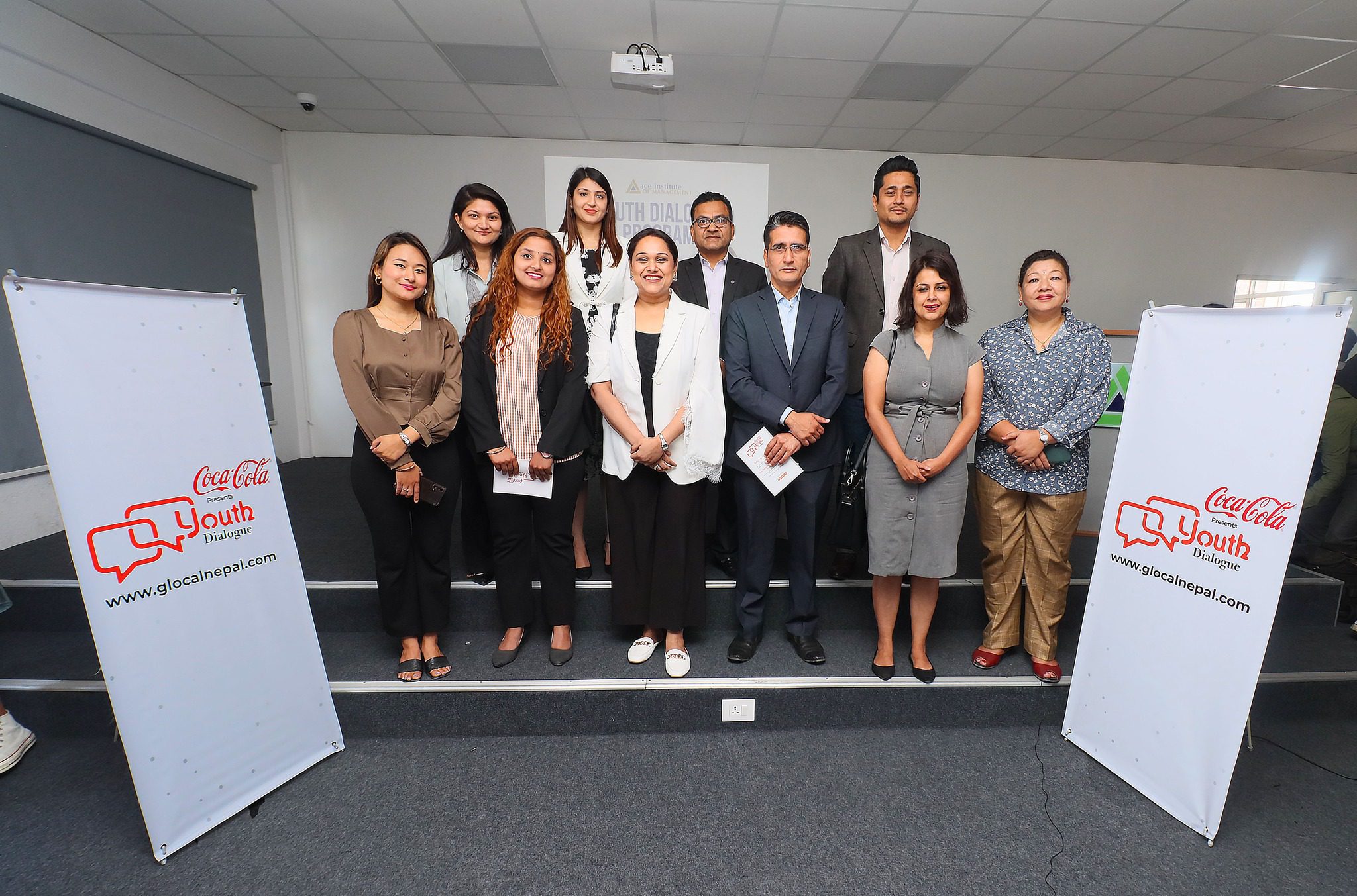Glocal Pvt. Ltd. organizes the monthly series of youth-focused discussion sessions known as Coca-Cola Presents Youth Dialogue. It is a platform where different people from different sectors share their experiences, challenges, and motivations.
Youth dialogue delivered fascinating sessions on a variety of topics like sport, environment, entertainment, business, culture, and tourism to develop skills for an ever-changing market. The speakers of the program include youth influencers, skillful people, entrepreneurs, politicians, and celebrities. The discussion series is one hour long and includes a live audience.
The Youth Dialogue 2.0 episode of Coca-Cola presents Youth Dialogue on the topic “Building Personal Brands” and ends with a successful presence of students amidst an event held at the premises of Ace Institute of Management, Kathmandu. The dialogue had the presence of three distinguished panelists as the invitees of the Youth Dialogue and they were:
- Ms. Asra Bhattarai, Marketing Consultant for Nepal & Bhutan at The Coca- Cola Company; Brand Strategist
- Ms. Mannsi Agrawal, International Corporate Trainer
- Mr. TikaRam Yatri, Journalist
Here is the gist of the discussion
When asked what’s the first thing that springs to your mind if you think of the word “brand”, Ms. Mansi shared that if asked about the brands, Coca-Cola and Ncell would be her first thoughts. She mentioned that Coca-Cola’s red and white symbol is iconic and deeply ingrained in people’s minds in many countries, while Ncell has successfully established its brand in Nepal. Ms. Mansi also believed that investing in personal branding is crucial in today’s changing economy, as it opens up numerous opportunities. She emphasized the importance of personal branding for success in the current economy.
Similarly, Ms. Asra expressed that when she hears the word “brand,” the concept of personality comes to her mind. Just like each of us carries a unique personality, every brand also has its personality. She highlighted that the efforts in building a brand revolve around creating a personality that people can connect to, and that, to her, is the essence of branding.
Mr. Tika Ram employed a simple analogy involving a mineral water bottle to explain branding. Placing it on a table renders the brand visible to both immediate and remote audiences, effectively conveying a brand message. His own decade-long personal branding efforts, championing the Nepali language, have been impactful, causing people to link him with language advocacy and enthusiasm.
He also touched on organizational branding, exemplifying the success stories of Coca-Cola and Ncell as major brands. The remarkable transformation of Coca-Cola over 137 years and Ncell’s shift from “mero mobile” were highlighted. He observed that individuals and even nations are now regarded as brands, citing India’s “Incredible India” initiative. He underscored how the proper personal branding of representatives can greatly influence a nation’s overall branding as well.
Coca-Cola’s remarkable journey and branding strategies
Ms. Asra pointed out the significance of maintaining uniformity in product and presentation to remain relevant. She pointed out that Coca-Cola’s knowledge of its target audience distinguishes it from other brands. She said the company prioritizes effective audience communication and adapts to market changes by extensively researching audience preferences, media habits, and messaging. Ms. Bhattarai gave instances of adapting campaign themes based on audience needs, like the pandemic-themed “Thank You” and “Relations” during Dashain reunions.
Regarding Coca-Cola’s strategies, Ms. Asra connected her response to prior answers. She stressed that Coca-Cola is clear about its target audience which is the 18-35 age group. The focus is on understanding this audience’s desires and establishing the brand’s identity. She noted that aligning emotions, particularly happiness, with Coke’s branding has facilitated stronger connections with a wider audience.
Grasping requirements and establishing links through sponsorships, brand ambassadors, or messaging are vital for maintaining brand consistency. Despite shifts in the market, maintaining a distinct understanding of both the target audience and the brand guarantees a consistent approach.
7 reasons to never ever travel to Nepal
When asked about ways to grow personal branding referring to her viral video titled “7 reasons to never ever travel to Nepal” Ms. Mansi shared that the video was a fluke. She admitted she hadn’t anticipated posting it online and ever expected it to go viral but surprisingly, the video went wildly viral, accumulating within a few hours, which astonished her. Although she was a corporate trainer, she received attention in the tourism domain, which was not her field of expertise. Despite the unintended disruption, it worked out for her.
To achieve uniqueness in personal branding, Ms. Mansi explained the evolution of social media’s power in democratizing brand creation. Previously, building a brand required money or media gatekeepers, but now, anyone with an idea, an internet connection, a method can have a voice and platform. Today social media is democratizing power, making it easy and accessible to build a personal brand. She drew the focus on creating a consistent and unique message at the beginning of content that is essential for building a brand on social media. The key lies in delivering content aligned with personal identity while crafting an attention-grabbing introduction.
Journalistic Experience and Media’s Role in shaping Brand Image
When inquired about his experience as a journalist and the role media played in shaping his brand’s image, Mr Tika Ram drawing from his decades-long journey of journalism, pointed out the importance of avoiding rigidity within a single firm, as it can hinder creativity.
He expressed, despite his successful work tenure at AP1 TV, he felt his identity was overly synonymous with AP1. This realization led him to register his own company and establish his personal brand through a YouTube channel titled “Tika Ram Yatri.” His show, “Tamso Ma Jyotirgamaya,” played a pivotal role in his branding journey.
Taking reference from his YouTube success, exemplified by his channel gaining 27 thousand subscribers within a week of launch, the rapid monetization of the channel indicated the significance of patience, skill, and unwavering personal branding. He emphasized that constructing a personal brand demands dedication and time, rather than occurring in an instant. While he cherished his time at AP1 TV, he acknowledged the potency of his personal brand in shaping his current success. He stressed the significance of branding in the digital era, offering prospects of financial gain and recognition. He linked this idea to media, explaining how news has shifted from traditional outlets to digital platforms like social media. In essence, he emphasized that understanding the value of trends, consistency, and relevance is vital while still having room for innovation and setting new trends.
Personal Branding in the Gig Economy
When queried about the role of storytelling in enhancing brand identity, Ms. Mansi stressed that personal branding is pivotal regardless of one’s career path, whether as professionals, service providers, entrepreneurs, or dream chasers. In the gig economy, companies favor hiring freelancers for specific tasks to cut costs and tap into fresh talents.
To forge a robust personal brand, Ms. Mansi suggested that individuals consider the brand attributes they wish to be linked with. These attributes can be divided into three pillars: areas of confidence, communication style, and fundamental brand components. By recounting life experiences that align with these pillars, individuals can genuinely narrate their journey and establish recognition within their chosen field.
Ms. Agrawal exemplified the impact of storytelling in brand development by sharing her own narrative of grappling with public speaking before large audiences. By sharing genuine stories that resonate with chosen brand attributes, individuals can fortify their brand and cultivate a relatable perception. Even if not directly selling something, having a clear personal brand holds significance. She urged individuals to embrace storytelling as a potent tool to shape their personal brand, paving the way for success in the gig economy and beyond.
Ways to Empower Youth to build Personal Brands
When asked about ways to encourage youth to build their personal brands, Ms. Asra stressed the importance of authenticity and self-awareness, urging individuals to understand themselves first. Regardless of fame, being true to oneself was vital. She believed that authenticity was sufficient, advising individuals to embrace themselves and trust the process. To ensure brand success, Ms. Bhattarai pointed out persistence in building and maintaining consistent service is crucial. She exemplified Coca-Cola to illustrate the importance of quality and reliability, warning against inconsistent service that can alienate the audience.
Adding to this, Ms. Mansi weighed on everyone being a brand. She explained that a personal brand is the perception others have when discussing an individual. Ms. Agrawal encouraged individuals to understand how they’re perceived by asking friends for feedback and recognizing patterns in those responses. She highlighted that enhancing this perception would lead to opportunities in the gig economy, better deals, collaborations, and more control over one’s work choices.
The need to understand audiences’ preferences was mentioned as essential. Ms. Agrawal further shared her own personal story of how she targeted HR managers and CEOs for training, highlighting the importance of staying committed to the brand message despite criticism. She also discussed the significance of visual and aesthetic alignment and clear communication mediums like English to connect with the audience effectively, contributing to brand growth.
Drawing on 21 years of expertise, Mr. Tika Ram emphasizes the importance of understanding oneself and pursuing genuine interests, citing his own journey from engineering to journalism as an example. Prioritizing personal satisfaction leads to branding, recognition, and success, while individual creativity sets you apart.
Keys to Brand Success: The Power of Persistence and Consistency
To ensure brand success, Ms. Asra emphasized persistence in building and maintaining consistent service. She used Coca-Cola to illustrate the importance of quality and reliability, warning against inconsistent service that can alienate the audience.
Ms. Mansi supported this by stressing the need to understand audience preferences. She shared how she targeted HR managers and CEOs for training, highlighting the importance of staying committed to the brand message despite criticism. Ms. Mansi also discussed the significance of visual and aesthetic alignment and clear communication mediums like English to connect with the audience effectively, contributing to brand growth.
Summing up, the discussion drew valuable insights from panelists and active audience participation. The need for authenticity, self-awareness, and enthusiasm were the key takeaways in forming a personal brand. Irrespective of fame or followers, remaining genuine, valuing uniqueness, and pursuing individual passions result in potent branding and eventual success across diverse life domains.





